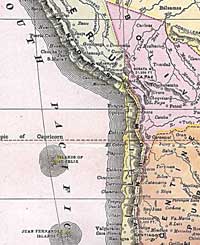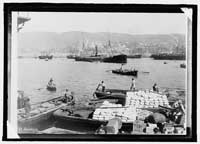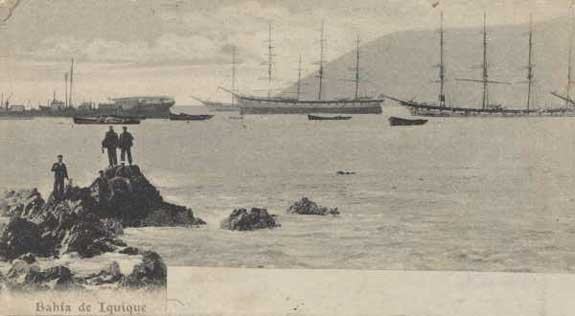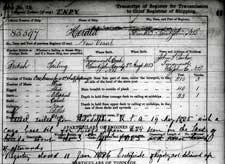Older and Wiser: To Valparaiso and Iquique
 The Herald (1445 tons) was the ship on which Johnson made the last of his deep-sea voyages known to the “More Than a List of Crew” research team. The vessel, the newest addition to the Troop fleet, departed Liverpool in 1883 for Valparaiso, Chile. Johnson went as mate on a voyage lasting thirteen months. He had served as master with Jacob and Howard Troop of St. John [N.B] since 1879, yet having no navigational knowledge of the west coast of South America, nor officer experience on a vessel of Herald’s size, an appointment as mate was the best that he could expect. Over the previous decade his voyages were confined to North Atlantic and Baltic waters. A South American venture is thus surprising, and all the more so because few men of forty years were still at sea unless they were serving as masters. As the Herald’s oldest seafarer bar the steward, Johnson might well have begun to feel his age on this voyage. But when he left the vessel he had the tidy sum of £120 for his retirement funds.
The Herald (1445 tons) was the ship on which Johnson made the last of his deep-sea voyages known to the “More Than a List of Crew” research team. The vessel, the newest addition to the Troop fleet, departed Liverpool in 1883 for Valparaiso, Chile. Johnson went as mate on a voyage lasting thirteen months. He had served as master with Jacob and Howard Troop of St. John [N.B] since 1879, yet having no navigational knowledge of the west coast of South America, nor officer experience on a vessel of Herald’s size, an appointment as mate was the best that he could expect. Over the previous decade his voyages were confined to North Atlantic and Baltic waters. A South American venture is thus surprising, and all the more so because few men of forty years were still at sea unless they were serving as masters. As the Herald’s oldest seafarer bar the steward, Johnson might well have begun to feel his age on this voyage. But when he left the vessel he had the tidy sum of £120 for his retirement funds.
It is easier to explain the commercial motives for the Herald’s voyage than Johnson’s reasons for taking a berth. The Pacific War had disrupted a lucrative market for British exporters on the west coast of South America over the previous four years. The Herald must have been loading at Liverpool [U.K] even before the peace of October 1883 became known, but this was the age of the telegraph, and promptly the vessel was dispatched to Valparaiso. A few passengers were aboard, so a steward and stewardess augmented its 17-man deck crew.
 In July 1884 the cargo was offloaded at its destination and then, as a chance note on the Agreement indicates, the ship went in ballast to Iquique. There was just one reason for going to that port, to load “Chili saltpetre” (Stevens 1878, 537). Nitrate of soda, as it was more properly known, had been exported from the Andes to Europe for several decades to be used in the manufacture of sulphuric and nitric acid. Not the easiest of sea-borne cargoes to deal with since it was soluble on contact with water, aside from leakage the wooden vessel was a better receptacle for nitrate than one with a metal hull. Stevens on Stowage commended its hardening effects on wood (Stevens 1878, 543). The Herald delivered its cargo at Hamburg, a Continental terminus that was emerging as a transshipment port.
In July 1884 the cargo was offloaded at its destination and then, as a chance note on the Agreement indicates, the ship went in ballast to Iquique. There was just one reason for going to that port, to load “Chili saltpetre” (Stevens 1878, 537). Nitrate of soda, as it was more properly known, had been exported from the Andes to Europe for several decades to be used in the manufacture of sulphuric and nitric acid. Not the easiest of sea-borne cargoes to deal with since it was soluble on contact with water, aside from leakage the wooden vessel was a better receptacle for nitrate than one with a metal hull. Stevens on Stowage commended its hardening effects on wood (Stevens 1878, 543). The Herald delivered its cargo at Hamburg, a Continental terminus that was emerging as a transshipment port.

During the 1880s sailing ship owners were beginning to look harder for opportunities outside the North Atlantic since steamship operators had absorbed more of the middle distance trades. In 1883 with 22 vessels measuring more than 1000 tons apiece, the Troops were one of the largest ship owners in Atlantic Canada (Wallace 1937, 109-10). They still funded the building of large softwood ships in the locality of St. John, and continued to draw upon local capital. Howard and his father, Jacob, held the majority of the Herald’s shares. Its master was the next most significant shareholder, followed by the builder of the ship. Two women were investors, the wives of a druggist and of a merchant respectively. Their families could well have done business with the Troops. In addition, their listing as owners on the official document of registry establishes that married women had the legal status of property-owners, something that historians say was still in doubt in Atlantic Canada in the late nineteenth century (Backhouse 1988).
Henry Johnson was very likely known to these and other families investing in Troop ships, yet the personal connections that might once have been so important to his employment could not stem the passage of time. An ageing sailor was one of the first marginalized in the labour market when the terms moved decisively against the economics of sail in the second half of the 1880s. Johnson had navigated North Atlantic waters without incident during the few years he commanded the Electa, but he had not acquired the formidable reputation of a Captain Courageous, nor it seems had he ever been inclined to become a shipping investor. Soon he had reason to be thankful that he had not bound his fortunes closer to the Troops and more surely did he bless the fate that parted him from Captain Parker, the master of the Herald and a shareholder in the vessel, after this one voyage in 1884. Had he stayed, Henry Johnson would have taken his leave of the sea very differently than he did.
 Ships sometimes quietly go missing. When the next lengthy voyage of the Herald commenced, Parker and the Troops were probably pleased to have secured a shipment of oil from the United States to Japan. Market conditions were not promising, even at the discounted freight rates sailing ships commanded. After it left Philadelphia occasional reports were made of the ship’s progress. It was spotted between the Indonesian Islands of Java and Sumatra in September 1885, but nothing more was seen or heard, suggesting the Herald progressed no further than the Sunda Strait. Without wreckage or bodies to confirm the loss, friends and relatives continued to hope for the crew’s return. The closure of a vessel’s register was perhaps the moment when the personal and financial loss weighed most heavily on its owner. Some months after the Herald was reported overdue, this was a task that Howard Troop might conceivably have taken upon himself rather than delegate it to an office clerk. Maybe he reflected ruefully on its short existence, and on the loss of a more than twenty-man crew. No Agreement survives aside from that for the voyage to Valparaiso and Iquique, so the register book is our source of information on the Herald’s fate. The entry was closed in January 1886 when the Herald had made at most two voyages for the Troops.
Ships sometimes quietly go missing. When the next lengthy voyage of the Herald commenced, Parker and the Troops were probably pleased to have secured a shipment of oil from the United States to Japan. Market conditions were not promising, even at the discounted freight rates sailing ships commanded. After it left Philadelphia occasional reports were made of the ship’s progress. It was spotted between the Indonesian Islands of Java and Sumatra in September 1885, but nothing more was seen or heard, suggesting the Herald progressed no further than the Sunda Strait. Without wreckage or bodies to confirm the loss, friends and relatives continued to hope for the crew’s return. The closure of a vessel’s register was perhaps the moment when the personal and financial loss weighed most heavily on its owner. Some months after the Herald was reported overdue, this was a task that Howard Troop might conceivably have taken upon himself rather than delegate it to an office clerk. Maybe he reflected ruefully on its short existence, and on the loss of a more than twenty-man crew. No Agreement survives aside from that for the voyage to Valparaiso and Iquique, so the register book is our source of information on the Herald’s fate. The entry was closed in January 1886 when the Herald had made at most two voyages for the Troops.

 The “More Than a List of Crew” team fell to speculating on the cause of the Herald’s loss. The havoc wrought by piracy as well as cyclones in the region were considered, and although this was not the season for cyclones, pirates were a perennial threat. Then again the eastern part of the Sunda Strait was shallow, tidal, and reportedly in need of re-mapping after the coast was changed by the tsunami that followed Krakatoa’s eruption two years before the Herald appeared in these waters. Perhaps in the end it was Captain Parker’s inexperience around the islands that compromised the safety of his crew. The Troops were now deploying their vessels extensively in the shipment of cargoes of many kinds, and their navigators were outside their comfort zones.
The “More Than a List of Crew” team fell to speculating on the cause of the Herald’s loss. The havoc wrought by piracy as well as cyclones in the region were considered, and although this was not the season for cyclones, pirates were a perennial threat. Then again the eastern part of the Sunda Strait was shallow, tidal, and reportedly in need of re-mapping after the coast was changed by the tsunami that followed Krakatoa’s eruption two years before the Herald appeared in these waters. Perhaps in the end it was Captain Parker’s inexperience around the islands that compromised the safety of his crew. The Troops were now deploying their vessels extensively in the shipment of cargoes of many kinds, and their navigators were outside their comfort zones.
 Circumstances had surely changed since the days in the 1870s when St. Patrick with Johnson as its mate had plied North Atlantic and Baltic trading routes, often loading softwood lumber cargoes when Atlantic Canadian ports were included in the route. Johnson had seen his share of exotic commodities, yet it was his experience with timber cargoes that served him in his mid-life transition from sea to shore.
Circumstances had surely changed since the days in the 1870s when St. Patrick with Johnson as its mate had plied North Atlantic and Baltic trading routes, often loading softwood lumber cargoes when Atlantic Canadian ports were included in the route. Johnson had seen his share of exotic commodities, yet it was his experience with timber cargoes that served him in his mid-life transition from sea to shore.
Had one met him in the streets of Moncton early in the 1890s, Johnson might have introduced himself as the part-owner of a furniture store. In 1889 his marriage to Maggie, 21 years his junior, brought Johnson into the family of furniture-maker and retailer, Hugh Bustin, but his father-in law’s business acumen did not keep the store afloat. After it folded Johnson had two jobs, as doorman at the Royal Bank of Canada and caretaker of the Masonic hall. In this employment he might be imagined halting passers-by to tell the tales of his days at sea (Moncton Daily Times). Less the port’s Captain’s Courageous, Johnson was still not Moncton’s “ordinary Joe”.
